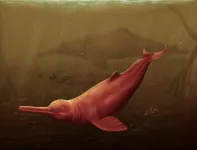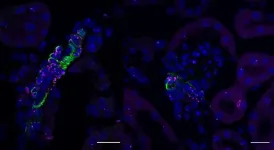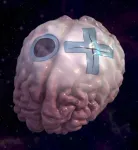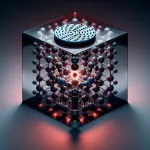(Press-News.org) WEST LAFAYETTE, Ind. — Sometimes planetary physics is like being in a snowball fight. Most people, if handed an already-formed snowball, can use their experience and the feel of the ball to guess what kind of snow it is comprised of: packable and fluffy, or wet and icy.
Using nearly the same principles, planetary scientists have been able to study the structure of Europa, Jupiter’s icy moon.
Additional Information
When worlds collide: Studying impact craters to uncover the secrets of the solar system
Breaking in a new planet
Purdue scientists and engineers push the boundaries of space knowledge, studying the stars, the solar system and beyond
Europa is a rocky moon, home to saltwater oceans twice the volume of Earth’s, encased in a shell of ice. Scientists have long thought that Europa may be one of the best places in our solar system to look for nonterrestrial life. The likelihood and nature of that life, though, heavily depend on the thickness of its icy shell, something astronomers have not yet been able to ascertain.
A team of planetary science experts including Brandon Johnson, an associate professor, and Shigeru Wakita, a research scientist, in the Department of Earth, Atmospheric, and Planetary Sciences in Purdue University’s College of Science, announced in a new paper published in Science Advances [ES1] that Europa’s ice shell is at least 20 kilometers thick.
To reach their conclusion, the scientists studied large craters on Europa, running a variety of models to determine what combination of physical characteristics could have created such a surface structure.
“This is the first work that has been done on this large crater on Europa,” Wakita said. “Previous estimates showed a very thin ice layer over a thick ocean. But our research showed that there needs to be a thick layer — so thick that convection in the ice, which has previously been debated, is likely.”
Using data and images from the spacecraft Galileo, which studied Europa in 1998, Johnson analyzed the impact craters to decode truths about Europa’s structure. An expert in planetary physics and colossal collisions, Johnson has studied almost every major planetary body in the solar system. Scientists have long debated the thickness of Europa’s ice shell; no one has visited to measure it directly, so scientists are creatively using the evidence at hand: the craters on Europa’s icy surface (video of impact simulation).
“Impact cratering is the most ubiquitous surface process shaping planetary bodies,” Johnson said. “Craters are found on almost every solid body we’ve ever seen. They are a major driver of change in planetary bodies. When an impact crater forms, it is essentially probing the subsurface structure of a planetary body. By understanding the sizes and shapes of craters on Europa and reproducing their formation with numerical simulations, we’re able to infer information about how thick its ice shell is.”
Europa is a frozen world, but the ice shelters a rocky core. The icy surface, though, is not stagnant. Plate tectonics and convection currents in the oceans and the ice itself refresh the surface fairly frequently. This means the surface itself is only 50 million to 100 million years old — which sounds old to short-lived organisms like humans, but is young as far as geological periods go.
That smooth, young surface means that craters are clearly defined, easier to analyze and not very deep. Their impacts tell scientists more about the icy shell of the moon and the water ocean below, rather than conveying much information about its rocky heart.
“Understanding the thickness of the ice is vital to theorizing about possible life on Europa,” Johnson said. “How thick the ice shell is controls what kind of processes are happening within it, and that is really important for understanding the exchange of material between the surface and the ocean. That is what will help us understand how all kinds of processes happen on Europa — and help us understand the possibility of life.”
About Purdue University
Purdue University is a public research institution demonstrating excellence at scale. Ranked among top 10 public universities and with two colleges in the top four in the United States, Purdue discovers and disseminates knowledge with a quality and at a scale second to none. More than 105,000 students study at Purdue across modalities and locations, including nearly 50,000 in person on the West Lafayette campus. Committed to affordability and accessibility, Purdue’s main campus has frozen tuition 13 years in a row. See how Purdue never stops in the persistent pursuit of the next giant leap — including its first comprehensive urban campus in Indianapolis, the new Mitchell E. Daniels, Jr. School of Business, and Purdue Computes — at https://www.purdue.edu/president/strategic-initiatives.
Writer/Media contact: Brittany Steff, bsteff@purdue.edu
Source: Brandon Johnson, bcjohnson@purdue.edu
END
Icy impacts: Planetary scientists use physics and images of impact craters to gauge the thickness of ice on Europa
Jupiter’s icy moon may be the next place humans find life, but first, they need to understand the structure of the moon
2024-03-20
ELSE PRESS RELEASES FROM THIS DATE:
Ancient giant dolphin discovered in the Amazon
2024-03-20
Measuring between 3 to 3.5 meters, 16 million years old: Paleontologists from the University of Zurich have announced the discovery of a new species of freshwater dolphin in the Peruvian Amazon region. Surprisingly, its closest living relatives can be found in the river dolphins of South Asia.
River dolphins are among the rarest modern cetaceans, with most extant species critically endangered. Despite their similar appearance, however, these animals are not directly related, but represent the late survivors of different cetacean groups that once inhabited our planet.
An international ...
Study suggests an ‘odor sensor’ may explain male and female differences in blood pressure
2024-03-20
Using data from both mice and humans, a Johns Hopkins Medicine research team has found that a cell surface protein that senses odors and chemicals may be responsible for — and help explain — sex differences in mammalian blood pressure. The unusual connection between such protein receptors and sex differences in blood pressure, reported in the March 20 issue of Science Advances, may lead to a better understanding of long known differences in blood pressure between females and males.
Blood ...
Repairing patients’ dura more durably
2024-03-20
Repairing patients’ dura more durably
Highly adhesive and mechanically strong Dural Tough Adhesive addresses multiple limitations in the repair of the dural membrane lining the brain and spinal cord after trauma and surgeries.
By Benjamin Boettner
(BOSTON) — The dural membrane (dura) is the outermost of three meningeal layers that line the central nervous system (CNS), which includes the brain and spinal cord. Together, the meninges function as a shock-absorber to protect the CNS against trauma, circulate nutrients throughout the CNS, as well as remove waste. The dura also is a critical biological barrier that contains cerebrospinal fluid (CSF) surrounding ...
Quantum talk with magnetic disks
2024-03-20
Quantum computers promise to tackle some of the most challenging problems facing humanity today. While much attention has been directed towards the computation of quantum information, the transduction of information within quantum networks is equally crucial in materializing the potential of this new technology. Addressing this need, a research team at the Helmholtz-Zentrum Dresden-Rossendorf (HZDR) is now introducing a new approach for transducing quantum information: the team has manipulated quantum bits, so called qubits, by harnessing the magnetic field ...
Earlier retirement for people with chronic musculoskeletal pain
2024-03-20
Frequent musculoskeletal pain is linked with an increased risk of exiting work and retiring earlier, according to a new study from the University of Portsmouth.
The paper published this week in open-access journal PLOS ONE found the association between musculoskeletal pain and retiring earlier persisted even after accounting for working conditions, job satisfaction and sex.
Dr Nils Niederstrasser and colleagues used data on 1,156 individuals aged 50+ living in England who took part in the English Longitudinal Study of Ageing. Over the course of the 14-year data collection period, 1,073 of the individuals retired.
The researchers found that people with musculoskeletal ...
Tiny magnetic implants enable wireless healthcare monitoring
2024-03-20
A millimeter-scale, chip-less and battery-less implant can wirelessly monitor a series of parameters within your body and communicate with a wearable device attached on the skin. In a recent study published in the journal Science Advances, researchers from Peking University have unveiled a miniaturized implantable sensor capable of health monitoring without the need of transcutaneous wires, integrated circuit chips, or bulky readout equipment, thereby reducing infection risks, improving biocompatibility, and enhancing portability.
Han Mengdi from Peking University, the lead researcher of ...
New study suggests that while social media changes over decades, conversation dynamics stay the same
2024-03-20
Published in Nature, a new study has identified recurring, ‘toxic’ human conversation patterns on social media, which are common to users irrespective of the platform used, the topic of discussion, and the decade in which the conversation took place.
In particular, the study suggests that prolonged conversations on social media are more prone to toxicity, and polarisation, when divergent viewpoints from debate lead to an escalation of online disagreement.
Contrary to the prevailing assumption, the study suggests that toxic interactions do not deter users from engagement, they actively participate in conversations. It also suggests that toxicity ...
Study finds non-immune brain cells can acquire immune memory, may drive CNS pathologies like multiple sclerosis
2024-03-20
Immunological memory — the ability to respond to a previously encountered antigen, or foreign substance, with greater speed and intensity on re-exposure is a hallmark of adaptive immunity. Innate immune cells also develop metabolic and epigenetic memories that boost their responses, but it was previously unknown if non-immune cells like astrocytes, which interact with immune cells and contribute to inflammation in the central nervous system (CNS), acquire aspects of immune memory of encountering ...
Canada should ban all unhealthy food marketing children may be exposed to
2024-03-20
Quebec City, March 20, 2024–Canada should ban marketing of unhealthy foods wherever children may be exposed, whether on TV, social media or billboards. This is one of the main conclusions of a Canada-wide study involving more than fifty food and nutrition experts made public today by a team from Université Laval's Faculty of Agriculture and Food Sciences.
The study, conducted as part of a research program funded by the Canadian Institutes of Health Research, also recommends better funding ...
The 7th World Conference on Targeting Phage Therapy, taking place in Malta in 2024, will showcase current developments in phage therapy and offer strategic insights into its future directions
2024-03-20
The 7th World Conference on Targeting Phage Therapy 2024 is set to take place on June 20-21 at the Corinthia Palace Malta, introducing the latest advancements within the field of phage research and therapy.
Robert T. Schooley, M.D., Professor of Medicine at the University of California, San Diego, and Co-Director of the Center for Innovative Phage Applications and Therapeutics, will lead the discourse, presenting insights and strategies essential to Phage Therapy in his talk titled "Phage Therapeutics 2024: Essential Translational Research Components for Clinical Trials."
Agenda at a Glance
Day One: will focus on Phages, Hosts & Microbiome, exploring ...
LAST 30 PRESS RELEASES:
Norbert Holtkamp appointed director of Fermi National Accelerator Laboratory
New agentic AI platform accelerates advanced optics design
Biologists discover neurons use physical signals — not electricity — to stabilize communication
Researchers discover that a hormone can access the brain by hitchhiking
University of Oklahoma researcher awarded funding to pursue AI-powered material design
Exploring how the visual system recovers following injury
Support for parents with infants at pediatric check-ups leads to better reading and math skills in elementary school
Kids’ behavioral health is a growing share of family health costs
Day & night: Cancer disrupts the brain’s natural rhythm
COVID-19 vaccination significantly reduces risk to pregnant women and baby
The role of vaccination in maternal and perinatal outcomes associated with COVID-19 in pregnancy
Mayo Clinic smartwatch system helps parents shorten and defuse children's severe tantrums early
Behavioral health spending spikes to 40% of all children’s health expenditures, nearly doubling in a decade
Digital cognitive behavioral treatment for generalized anxiety disorder
Expenditures for pediatric behavioral health care over time and estimated family financial burden
Air conditioning in nursing homes and mortality during extreme heat
The Alps to lose a record number of glaciers in the next decade
What makes a good proton conductor?
New science reporting guide published for journalists in Bulgaria
New international study reveals major survival gaps among children with cancer
New science reporting guide published for journalists in Turkey
Scientists develop a smarter mRNA therapy that knows which cells to target
Neuroanatomy-informed brain–machine hybrid intelligence for robust acoustic target detection
Eight SwRI hydrogen projects funded by ENERGYWERX
The Lundquist Institute and its start-up company Vitalex Biosciences Announces Strategic Advancement of Second-Generation fungal Vaccine VXV-01 through Phase 1 Trials under $40 Million Competitive Con
Fine particles in pollution are associated with early signs of autoimmune disease
Review article | Towards a Global Ground-Based Earth Observatory (GGBEO): Leveraging existing systems and networks
Penn and UMich create world’s smallest programmable, autonomous robots
Cleveland researchers launch first major study to address ‘hidden performance killer’ in athletes
To connect across politics, try saying what you oppose
[Press-News.org] Icy impacts: Planetary scientists use physics and images of impact craters to gauge the thickness of ice on EuropaJupiter’s icy moon may be the next place humans find life, but first, they need to understand the structure of the moon





